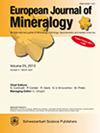氧化镁-氧化锌二元体系中岩盐相与乌兹石相在 3.5 GPa 下的混溶间隙
IF 1.7
3区 地球科学
Q2 MINERALOGY
引用次数: 0
摘要
摘要。在常压下,氧化镁以岩盐(B1)结构结晶,而氧化锌则以钨锌矿结构(B4)结晶。随着压力的增加,氧化镁-氧化锌二元体系中这两种结构之间的非对称混溶性间隙逐渐缩小,最终在 1000 ∘C、约 5 GPa 的温度下发生纯氧化锌的钨锌矿到岩盐的相变。尽管氧化镁-氧化锌二元体系中的压力-温度-组成(P-T-X)关系非常简单,但实验研究却很少,其结果与现有的热力学数据不一致。在此,我们报告了从 940 到 1500 ∘C 和 0 到 3.5 GPa 的混溶间隙的 P-T-X 关系的实验测定结果,并将其与文献中的热量测定数据和状态方程数据以及内质氧化锌的转变数据相结合,建立了一个热力学模型,解决了许多不一致的问题。该模型将岩盐相视为理想溶液(无过剩的混合吉布斯自由能),而在实验获得的成分范围内,晶格相中的氧化镁成分遵循亨利定律,氧化锌成分遵循拉乌尔特定律。然而,根据该模型推断出的钨锰结构氧化镁的部分摩尔体积与淬火样品中通过 X 射线衍射测量晶格参数推断出的部分摩尔体积不一致。造成这种差异的原因可能是相当一部分取代的 Mg2+ 无法淬火地无序进入钨锆石结构中通常空置的八面体间隙。本文章由计算机程序翻译,如有差异,请以英文原文为准。
The miscibility gap between the rock salt and wurtzite phases in the MgO–ZnO binary system to 3.5 GPa
Abstract. At ambient pressure, MgO crystallizes in the rock salt (B1) structure, whereas ZnO crystallizes in the wurtzite structure (B4). The asymmetric miscibility gap between these two structures in the MgO–ZnO binary system narrows with increasing pressure, terminating at the wurtzite-to-rock-salt phase transition in pure ZnO, which occurs at approximately 5 GPa at 1000 ∘C. Despite their essential simplicity, the pressure–temperature–composition (P–T–X) relations in the MgO–ZnO binary system have been sparsely studied experimentally, with disparate results that are inconsistent with available thermodynamic data. Here we report the experimental determination of the P–T–X relations of the miscibility gap from 940 to 1500 ∘C and 0 to 3.5 GPa, which we combine with calorimetric and equation-of-state data from the literature and on the transition in endmember ZnO, to build a thermodynamic model that resolves many of the inconsistencies. The model treats the rock salt phase as an ideal solution (no excess Gibbs free energy of mixing), while in the wurtzite phase the MgO component follows Henry's law and the ZnO component Raoult's law in the range of compositions accessed experimentally. However, there is an inconsistency between the partial molar volume of wurtzite-structured MgO deduced from this model and that inferred from lattice parameter measurements by X-ray diffraction in the quenched samples. This discrepancy may be caused by unquenchable disordering of some significant fraction of the substituting Mg2+ into normally vacant octahedral interstices of the wurtzite structure.
求助全文
通过发布文献求助,成功后即可免费获取论文全文。
去求助
来源期刊
CiteScore
2.80
自引率
9.50%
发文量
40
审稿时长
6-12 weeks
期刊介绍:
EJM was founded to reach a large audience on an international scale and also for achieving closer cooperation of European countries in the publication of scientific results. The founding societies have set themselves the task of publishing a journal of the highest standard open to all scientists performing mineralogical research in the widest sense of the term, all over the world. Contributions will therefore be published primarily in English.
EJM publishes original papers, review articles and letters dealing with the mineralogical sciences s.l., primarily mineralogy, petrology, geochemistry, crystallography and ore deposits, but also biomineralogy, environmental, applied and technical mineralogy. Nevertheless, papers in any related field, including cultural heritage, will be considered.

 求助内容:
求助内容: 应助结果提醒方式:
应助结果提醒方式:


